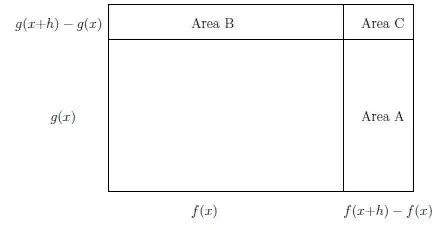The question "what does $f(x+h)g(x)$ mean" is easy to answer: It means the product of the numbers $f(x+h)$ and $g(x)$.
Now why are they added and subtracted? We can split that into two parts: Why is it added? And why is it then subtracted again?
The second part is easy to explain: We want an equality, so if we add something (other than $0$), we obviously have to subtract it again, or we'd not arrive at the same value as before.
But then, why are we adding it in the first place?
Well, we want to express the derivative of $f(x)g(x)$ by the derivatives of $f(x)$ and $g(x)$. Now the derivative of $f(x)$ is the limit of $(f(x+h)-f(x))/h$ and likewise for $g$. But we don't see those terms in the expression. However, we already see parts of those expressions. Let's transform the expression slightly top more clearly see that:
$$\frac{F(x+h)-F(x)}{h}=\frac{f(x+h)g(x+h)-f(x)g(x)}{h} = \frac{f(x+h)}{h}g(x+h) - f(x)\frac{g(x)}{h}$$
As you can see, there's the expression $f(x+h)/h$ which looks almost like the expression we have to take the limit of to get $f'(x)$, but there's something missing: The $-f(x)$ part. Well, if it is missing, let's just add it:
$$\frac{f(x+h)\color{red}{-f(x)}}{h}g(x+h)-f(x)\frac{g(x)}{h}$$
Now we have a nice difference quotient on the left side. But we changed the expression! Our expression is no longer the same we started with, and certainly doesn't equal $(F(x+h)-F(x))/h$. How to fix it? Well, simply add again what we just subtracted:
$$\frac{F(x+h)-F(x)}{h}=\frac{f(x+h)-f(x)}{h}g(x+h) \color{red}{+ \frac{f(x)}{h}g(x+h)} -f(x)\frac{g(x)}{h}$$
Now we are back at the original value, but still have the nice quotient. Moreover, we see that on the last two terms, we can move $f(x)$ out, to get
$$\frac{F(x+h)-F(x)}{h}=\frac{f(x+h)-f(x)}{h}g(x+h) + f(x)\frac{g(x+h)-g(x)}{h}$$
Now, that's even better! Now we also have the quotient in the right form for $g$! All we now have to do is to take the limit for $h\to 0$, and find
$$F'(x)=f'(x)g(x)+f(x)g'(x)$$
